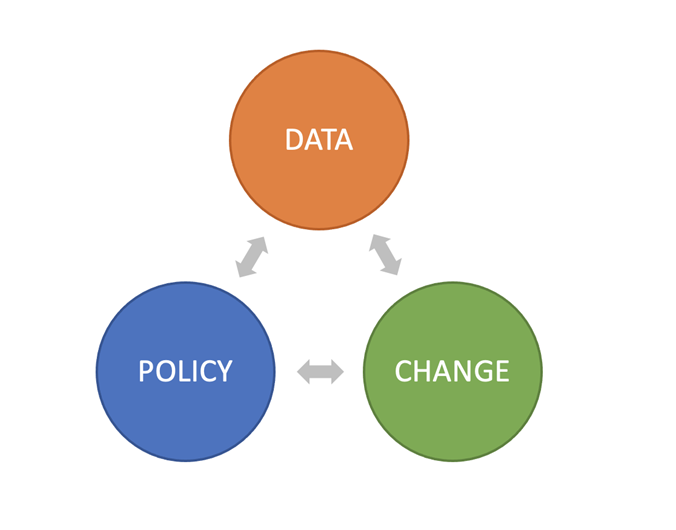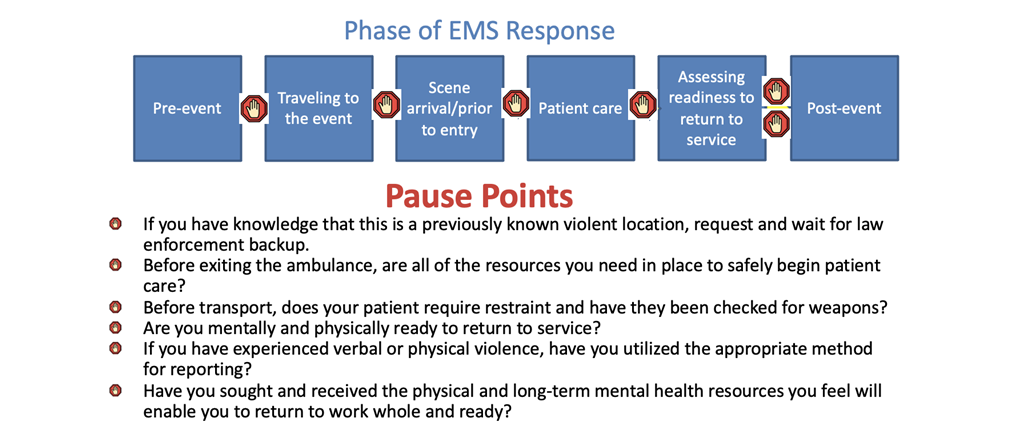Policy: Research to Practice (r2p)
Policy is one of the strongest tools in the public health toolbox. Policy often arises to address a problem that ideally has been identified through data collection and analysis. Once enacted, policy addresses the problem by prompting change. The FIRST Center recognizes the fundamental interconnectedness of policy, data, and change. Change cannot happen without policy, and policy cannot be enacted without data. Change can also demand new data collection, which leads to new policy, and so on.

When it comes to the fire and rescue service, policy research and implementation is lacking. Therefore, the FIRST Center works in collaboration with the fire service to develop model policies that can be modified for local implementation in departments around the country. FIRST conducts primary research to determine what data elements are needed to support fire and rescue service safety and health and investigates state policies to determine what legal benefits exist to protect first responders. Much of our work to date focuses on alleviating stress and workplace violence. If a fire department has developed an SOP or other policy that may benefit others seeking to do likewise, such documents can be found in the Fire Department Model Policies section. Publications specific to our policy work are cross-referenced here and can also be found on the main Publications tab.
Inclusion of Industry & Occupation Data Elements in National Healthcare Data
Through our previous FEMA funding, we launched a national policy effort regarding data standards for occupational surveillance. The ultimate goal was to convince national data standards maintenance organizations (under HIPAA and the US Department of Health and Human Services) to include data elements of industry and occupation (I/O) in all hospital encounters. The FIRST Center proposed using existing federal standards to facilitate this: the North American Industrial Classification System (NAICS) and standard occupation codes (SOC) developed by the Bureau of Labor Statistics (BLS). A national coalition of stakeholders in support of this national policy change was developed, including resolutions adopted by the Council for State and Territorial Epidemiologists and the Congressional Fire Services Institute. The halfway point was reached in the policy adoption process by obtaining 'Accredited Standard Committee X12' approval. To date, NUBC approval remains elusive. This paper discusses the rationale for I/O data inclusion and highlights the costs, benefits, and facility with which these missing data elements could benefit all workers.
Achieving NUBC approval would enable all inpatient and emergency department hospital visits by career and volunteer firefighters to be systematically captured. The documentation of industry and occupation information will not only benefit the fire service, but everyone who works. The politically charged reaction to the proposed policy changes hampered the initiative. The national coalition built around this initiative continued its efforts through the FIRST Reliability Study's pilot study to asses how long it takes to capture industry and occupation data during the patient registration process. The pilot study was conducted in two hospitals in Philadelphia, Pennsylvania.
The SAVER Systems-Level Checklist and Model Policies
Research has shown that violence is a significant contributor to stress. Stress is also the most frequently reported injury among EMS providers. Violence exposure is associated with increased anxiety, stress, and fear among EMS workers. In the FIRST Center's systematic review of violence against fire-based EMS responders, between 57 and 93% of EMS responders experienced an act of verbal and/or physical violence at least once. Combined with the increasing demand for services, the threat of violence adds another significant source of workplace stress.
Our systematic literature review led to the Stress and Violence to fire-based EMS Responders (SAVER) project, which was the first FEMA-funded grant to look at the EMS side of fire. This was important because EMS is 60 to 90% of what fire departments do. SAVER used an innovative application of traditional checklists by developing a systems-level intervention designed to shift the onus of safety and health from that of the individual first responder back onto the organization for whom they work.
Three high EMS volume fire departments participated in SAVER: Dallas Fire-Rescue, Philadelphia Fire Department, and San Diego Fire Rescue. In July of 2019, we convened over 40 fire and EMS thought leaders from 27 organizations for the SAVER Systems Checklist Consensus Conference (SC3). For two days, we asked attendees to modify and revise the Checklist to ensure it would meet the needs of responders.
The SAVER Systems-Level Checklist contains items focused on actions that leadership can institute through training and policy. From 174 original items, the fire service chose 80 as being feasible to implement in their departments within 3 to 6 months. In February of 2020, fire and EMS leadership, frontline workers, dispatchers, and labor union representatives from the three SAVER study sites re-convened to take these 80 checklist items and codify them into 8 domains that form the SAVER Model Policies:
- Mission Statement
- Defining Violence
- Dispatch: Communication & Coordination
- Assessment & Communication of Scene Conditions
- Standard Operating Procedures During Patient Care
- Readiness to Return to Service
- Event Reporting
- Mental & Physical Health Support
This family of policies are intended to be adopted together as a cohesive chapter within a fire department's policy manual. They express to members that there is a strong commitment to their safety, zero tolerance for violence against them, and that remedies to address job stress are being codified in policy.
While the organization has 80 items to worry about, the fire-based EMS responders only have six. These are called the SAVER Pause Points:

Pause Points empower the individual responder to speak up to the organization by sharing their experiences in the field as a way to give feedback on how the SAVER Model Policies are working. Pause Points flatten the organizational hierarchy by giving autonomy and decision-making to those who previously had little.
Please contact the FIRST Center if you are interested in implementing the SAVER Systems-Level Checklist and/or Model Policies in your department.
State Inventory of Workers' Compensation and Presumptive Legislation
Workers' compensation laws specify the types of support for physical injuries and traumatic events on the job. The FIRST Center conducted a comprehensive review of state workers' compensation laws in the United States to evaluate how these laws support first responders suffering from psychological conditions.
Findings revealed that, in most states, mental health falls into one of three categories:
- Physical-to-mental injury, or mental health issues arising from experiencing a physical injury
- Mental-to-physical injury, or physical harm resulting from a mental health crisis
- Mental-to-mental injury, or a mental health issue stemming from previous unresolved psychological concerns
All 50 states supported physical-to-mental injury claims, 44 supported mental-to-physical claims, and 40 supported mental-to-mental claims.
Further, the number of states that have presumption of causation laws for diseases associated with firefighting and EMS work (e.g., cardiovascular disease, respiratory disease, infectious disease, etc.) far outweighs the number of states that have mental health presumption laws. For example, 23 states were able to pass presumption laws for COVID-19 during the pandemic, while only 9 states have presumption of causation laws for mental health conditions.
In addition to these gaps in presumption policy from state to state, several barriers exist to individual first responders who are seeking support through the workers' compensation claims process. These include latency periods, time limits, and pre-existing health conditions. When an injury is psychological rather than physical in nature, first responders are likely to struggle with the burden of proof that the injury stems from their workplace.
To bridge these gaps in policy, states could implement presumptive coverage for first responder mental illness as a statute with a built-in "sunset" clause, or termination date. This models the pattern states utilized during the COVID-19 pandemic.
Summary of Policy Publications
Inclusion of Industry-Specific and Occupation Data Elements in National Healthcare Data
- Taylor JA, Widman SA, James SJ, Green-McKenzie J, McGuire C, Harris EJ (2017). Time Well Spent: Patient Industry and Occupation Data Collection in Emergency Departments. Journal of Occupational & Environmental Medicine, 59(8), 742-745. DOI: 10.1097/JOM.0000000000001088
- Taylor JA, Frey LT (2013). The Need for Industry and Occupation Standards in Hospital Discharge Data. Journal of Occupational and Environmental Medicine, 55(5), 495-499. DOI: 10.1097/JOM.0b013e318293af12
The SAVER Systems-Level Checklist and Model Policies
- Taylor JA, Murray RM, Davis AL, Brandt-Rauf S, Allen JA, Borse R, Pellecchia D, Picone D (2022). Model Policies to Protect US Fire-Based EMS Responders From Workplace Stress and Violence. New Solutions, 32(2), 119-131. DOI: 10.1177/10482911221085728
- Murray RM, Allen JA, Davis AL, Taylor JA (2020). Meeting science meets public health: Results from the "Stress and Violence in fire-based EMS Responders (SAVER)" Systems Checklist Consensus Conference (SC3). Journal of Safety Research, 74. DOI: 10.1016/j.jsr.2020.06.009
- Murray RM, Davis AL, Shepler LJ, Moore-Merrell L, Troup WJ, Allen JA, Taylor JA (2020). A Systematic Review of Workplace Violence Against Emergency Medical Services Responders. New Solutions, 29(4), 487-503. DOI: 10.1177/1048291119893388
- Taylor JA, Murray RM, Davis AL, Shepler LJ, Harrison CK, Novinger NA, Allen JA (2019). Creation of a Systems-Level Checklist to Address Stress and Violence in Fire-Based Emergency Medical Services Responders. Occupational Health Science, 3, 265-295. DOI: 10.1007/s41542-019-00047-z
- USFA (2017). Mitigation of Occupational Violence to Firefighters and EMS Responders.
Workers' Compensation and Presumptive Legislation